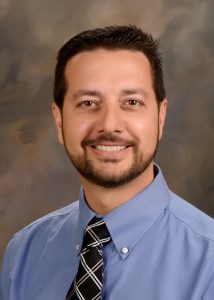Local Physicians Collaborating to Offer Great Care to Our Community

Dr. Craig DeLisi Family Care Center Mt. Pleasant
By: Dr. Craig Delisi, Family Care Center Mt. Pleasant
The news and our community continues to be inundated with COVID-19 information. It seems I hear from patients or neighbors daily asking about something they have heard or read through countless news outlets. Understanding and filtering all of the facts, figures, and theories can be exhausting for all of us.
As scientists worldwide scramble to find better treatments, medications, and hopefully a vaccine, I want to reassure each of you that the physicians and healthcare leaders in our community are working diligently to offer the best possible medical care and latest treatment options to our patients.
I feel that many may be wondering “Is our medical community, and our doctors specifically, willing to do whatever it takes to help care for those who contract Coronavirus?”
The answer to that is an unequivocal YES.
So does that mean that, at times we may use treatments that are not yet approved or widely accepted by the national and international medical community?
Yes.
Does that mean we will seek to obtain the resources, known and investigative, that will help us provide the highest level of care that we can provide in our community?
Yes.
Does that mean physicians and staff will study, learn, collaborate, pray, and then act in a given instance in accordance with what we think is the right treatment for a given person in a specific situation?
Yes, yes, yes.
All of those things have been happening from the beginning of the pandemic and will continue to happen throughout this crisis.
For example, TRMC has partnered with Mayo Clinic in order to offer convalescent plasma treatment to hospitalized patients. To date we have used it in many patients and seen lives saved with this breakthrough option.
You may have heard about the medication called Remdesivir. It has shown to provide the biggest mortality benefit in critically ill patients, yet it is not readily available to smaller hospitals and rural areas. Through appeals to state and federal government leaders and organizations, we were able to obtain 50 doses of this drug for our local patients, allowing us to treat those patients here in our hospital instead of transferring outside of our community. I suspect we are one of the smallest hospitals in Texas, (if not the U.S.), to have this resource. We also have taken advantage of a drug called dexamethasone in ventilated patients after a recent study demonstrated survival improvements. Individual physicians and practitioners in the community have used different medications in an outpatient setting, as they see fit, to treat this virus – azithromycin, albuterol, budesonide, zinc, hydroxychloroquine. These new treatments and medication options are always being reviewed and used whenever we feel there is a benefit to our patients.
Additional activities that have created better treatment for our patients include:
- We have negative pressure rooms available for COVID patients, and have created some extra make shift ones to use when capacity is surging.
- We have frequent COVID “huddles” – groups of physicians deciding the plan for a given patient – hospitalize, stay, transfer, interpretation of results, treatment specifics.
- A “task force” team of 15-20 clinicians, administrators and community members has met weekly for the last several months, discussing all matter of COVID related issues affecting our hospital and community.
- TRMC formed a team to call every patient TESTED by the health system for coronavirus DAILY, until they are well. The intent is to help people recognize signs of worsening symptoms that might require medical attention. At its peak, the daily “list” had included calling nearly 400 people each day.
- We have been in high level discussions with virtually every large business in this community (and many small ones) trying to help them minimize risk to employees and make decisions regarding return to work for those infected.
- Our team at the FCC has been flexible and has worked tirelessly to respond to the community need for increased testing, while maintaining safety for our other patients. To date we have tested over 1200 patients since May and cared for over 500 patients with COVID.
In my 24 years in medicine, I’ve never experienced the degree of collaboration among physicians that I’ve seen here during the last 4 months – neurologists, cardiologists, pulmonologists, hospitalists, surgeons, obstetricians, pediatricians, family physicians. We share articles, lend advice from our areas of expertise or our experience, and share new ideas. We have some highly intelligent men and women caring for this community, across many specialties. And those brains are thinking and talking together…very often.
Within that context, please understand that as medical staff, we are quick to listen and read and learn about new treatments, yet we are not hasty to assimilate them into practice. That is how it should be, and how you should want it to be. Primum non nocere (“First do no harm”) is not only part of a philosophy that physicians are taught in medical school, but it is really a mantra that is hardwired into the DNA of any caring doctor. It is important that ideas, especially for treatment administered to patients, come with a high level of confidence in their effectiveness and a low level of concern for their harm.
That does NOT mean, however, that we do not ever consider treatment unless it has been through rigorous double-blinded, placebo-controlled studies. Among the list of treatments I mentioned above, remdesivir is the only one that fits that criteria. In the middle of this pandemic, especially as we see very sick patients that we care about right here in our community, we are not always afforded the opportunity to wait for the highest levels of evidence, like we are accustomed to doing.
I said it at the beginning of this pandemic, and time has only proven it to be true – from a medical standpoint, we are very blessed to live in Titus County. We may not have a major medical center on every corner, but we also don’t have millions of citizens competing for access to that care. We have a strong primary care base and a hospital with excellent and broad specialty care, including intensive care and ventilators. And, to date, statistics have demonstrated how blessed we are. I ran the numbers myself this week. With nearly 1000 cases now, Titus county ranks number FIVE in number of cases per capita in the state of Texas (out of 254 counties). However, our mortality rate is ONE HALF of the state average and ONE SEVENTH of the national average. That tells me that the above efforts have proven fruitful…praise the Lord!
So, as you hear and read countless news reports over the coming months, rest assured that we also have heard and read many of the same stories and reports and have hopefully studied and given consideration to their validity. And while we shouldn’t try out every new therapy presented, be confident that we are committed to helping OUR patients in THIS community by any and every means that the Lord graciously allows us to have at our disposal. We are here and committed for the long haul to serve you and your family in the community we all love to call home.


